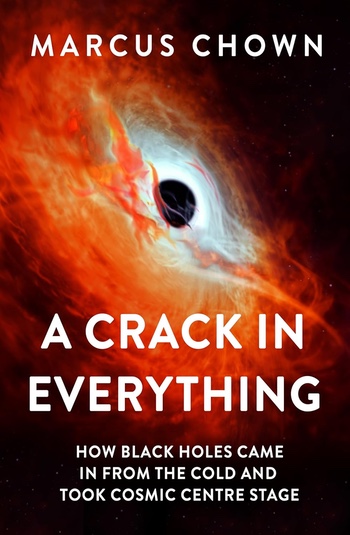Review: A Crack in Everythingby Jeff Foust
|
| “Far from being black,” he writes in the introduction, “black holes are some of the most prodigiously luminous objects in the universe.” |
The book is as much a story of the people who advanced our knowledge of black holes as it is of black holes themselves. Most of the book’s ten chapters take the reader on a historical review, starting with German astronomer Karl Schwarzshild developing the theoretical underpinnings of black holes while sick in a German field hospital in World War I, and going to the scientists who led the development of the Event Horizon Telescope, which produced the first images of the black holes in the hearts of the galaxy M87 and our own Milky Way.
The focus throughout those chapters is on the people doing that research. They include well-known figures like Subrahmanyan Chandrasekhar and Maarten Schmidt to lesser-known figures like Paul Murdin, Louise Webster, and Tom Bolton, who linked an X-ray source known as Cygnus X-1 to a black hole. Chown notes that many of those accounts came from interviews he performed with those astronomers over the years. “It is hard to convey the thrill of putting down the phone after an hour or two of conversation with a notebook filled with stories very probably nobody else knows,” he writes.
That focus on the people, and the extensive use of interviews, helps the book stand out as well as overcome an odd weakness. “Far from being black,” he writes in the introduction, “black holes are some of the most prodigiously luminous objects in the universe.” But that luminosity is not on display in the book, which lacks any photos or illustrations of any kind beyond the one on the cover: nothing of black holes or the people who study them. Illustrations aren’t essential, but they are useful, and a lack of them in A Crack in Everything is a curious oversight.
The final chapters of the book explore our current knowledge about black holes along with some speculation, such as the ability of the black hole’s event horizon to encode information. Chown also examines the supermassive black hole in the Milky Way, which is not nearly as massive as astronomers expected. One possibility is that the original supermassive black hole was ejected in the galactic collisions that helped form the Milky Way, leaving behind a smaller one not powerful enough to sweep away gas that later formed stars like our Sun.
“And isn’t that the ultimate irony?” he concludes. “That black holes, once believed to be so ridiculous as to be not even the preserve of science-fiction, turn out not only to be the key to understanding why the universe is the way it is but also the key to understanding why you and I are here at all.”
Note: we are now moderating comments. There will be a delay in posting comments and no guarantee that all submitted comments will be posted.
